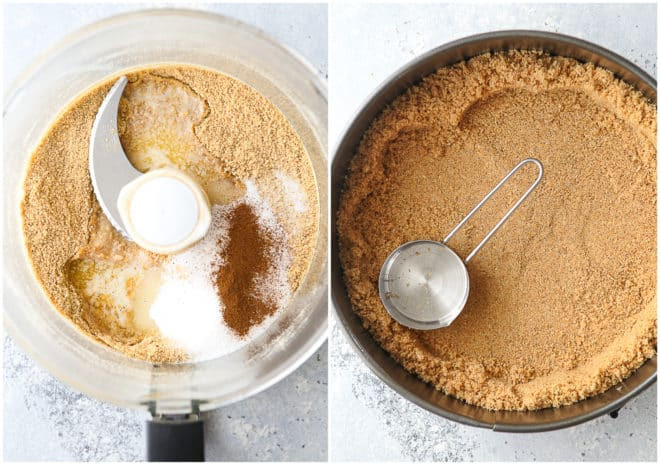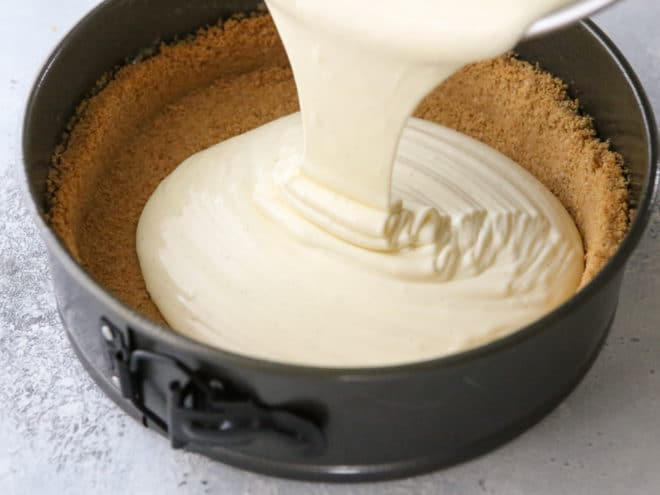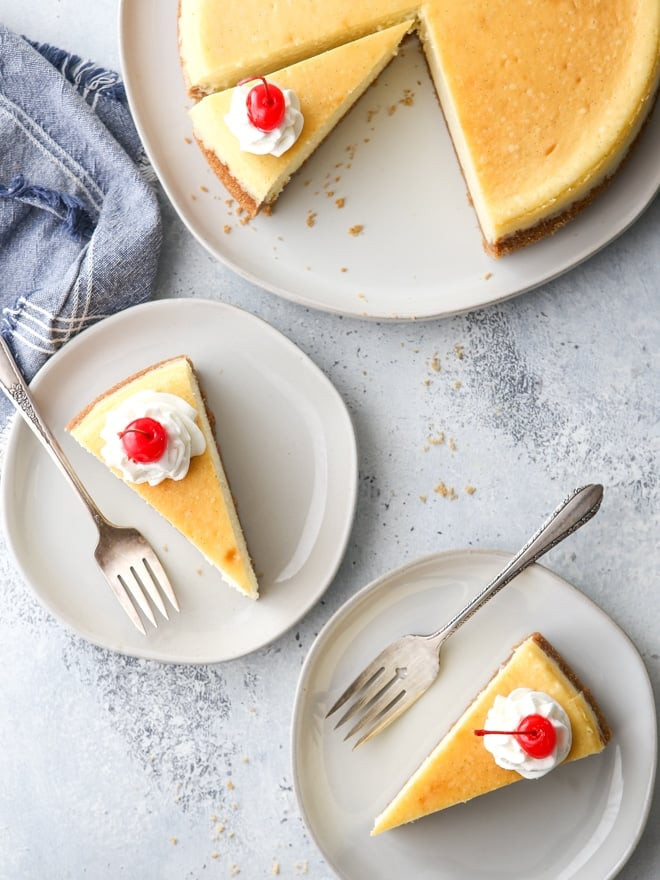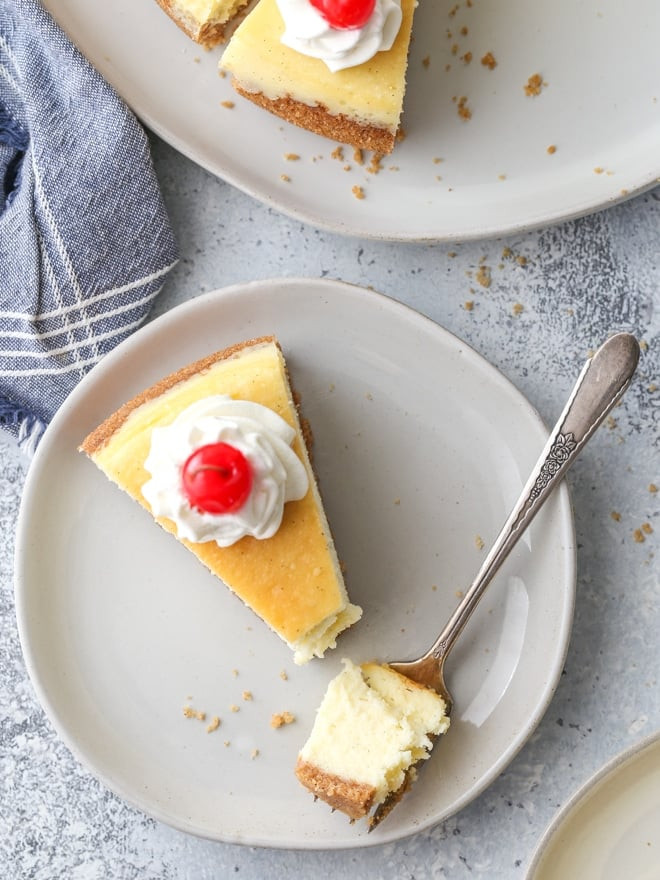An Old Fashioned Cheesecake Recipe creates a rich, creamy dessert perfect for any occasion, and mens-fashion.net is here to guide you. This timeless treat, with its smooth texture and satisfying flavor, is surprisingly simple to make at home. Discover how to create the ultimate vintage cheesecake, exploring its rich history and the simple ingredients that make it so special. Whether you’re a seasoned baker or just starting out, this guide will help you master the art of the classic cheesecake.
1. What Defines An Old Fashioned Cheesecake Recipe?
An old fashioned cheesecake recipe focuses on simplicity and rich flavor. Classic recipes often use basic ingredients like cream cheese, eggs, sugar, and vanilla extract to achieve a dense and creamy texture. Instead of modern twists, these cheesecakes emphasize traditional baking methods and authentic flavors.
Key Characteristics of Old Fashioned Cheesecake:
- Simple Ingredients: The recipe relies on a few high-quality ingredients.
- Dense Texture: Old fashioned cheesecakes are known for being dense and rich.
- Classic Flavor: The taste is dominated by the pure flavors of cream cheese and vanilla.
- Traditional Baking Methods: Water baths are commonly used to ensure even baking and prevent cracking.
2. What Are The Essential Ingredients For An Old Fashioned Cheesecake?
To bake an authentic old fashioned cheesecake, you’ll need a few key ingredients. According to culinary experts, the quality of these ingredients greatly influences the final product.
Ingredients List:
| Ingredient | Quantity | Purpose |
|---|---|---|
| Cream Cheese | 24 ounces (3 bricks) | Provides the creamy base of the cheesecake |
| Granulated Sugar | 1 ½ cups | Sweetens the cheesecake |
| Large Eggs | 4 | Binds the ingredients and adds richness |
| Vanilla Extract | 2 teaspoons | Enhances the flavor |
| All-Purpose Flour | 3 tablespoons | Helps stabilize the cheesecake |
| Heavy Cream | ¾ cup | Adds moisture and creaminess |




Tips For Ingredient Selection:
- Cream Cheese: Use full-fat cream cheese for the best texture. Soften it to room temperature before mixing.
- Eggs: Room temperature eggs incorporate more smoothly into the batter.
- Vanilla Extract: Opt for pure vanilla extract instead of imitation for a richer flavor.
3. What Equipment Do You Need To Bake A Classic Cheesecake?
Having the right equipment can make the baking process smoother and more successful. Here’s a list of essential tools:
Essential Equipment:
| Equipment | Purpose |
|---|---|
| 9-inch Springform Pan | Holds the cheesecake and allows for easy removal after baking |
| Mixing Bowls | Used for preparing the crust and the cheesecake filling |
| Electric Mixer | Ensures a smooth and consistent cheesecake batter |
| Measuring Cups and Spoons | Accurate measurement of ingredients for the perfect balance |
| Roasting Pan | Required for creating a water bath, which helps in even baking and prevents cracking |
| Aluminum Foil | Used to wrap the springform pan to prevent water from seeping in during the water bath |
4. How Do You Prepare A Graham Cracker Crust For An Old Fashioned Cheesecake?
A graham cracker crust provides a delicious foundation for your cheesecake. Here’s how to prepare it:
Ingredients For Graham Cracker Crust:
- 2 cups graham cracker crumbs (about 14 full sheets)
- 5 tablespoons melted butter
- 3 tablespoons granulated sugar
- ¼ teaspoon salt
- ¼ teaspoon ground cinnamon (optional)
Instructions:
- Combine Ingredients: In a mixing bowl, combine graham cracker crumbs, melted butter, sugar, and salt. Mix until well combined.
- Press Into Pan: Press the mixture firmly into the bottom of a 9-inch springform pan. You can also press it slightly up the sides of the pan.
- Bake: Bake the crust in a preheated oven at 350°F (175°C) for 10 minutes.
- Cool: Let the crust cool completely before adding the cheesecake filling.
Tips For A Perfect Crust:
- Even Layer: Use the bottom of a measuring cup to press the crust evenly into the pan.
- Prevent Soggy Crust: Baking the crust before adding the filling helps prevent it from becoming soggy.
5. What’s The Best Way To Mix The Cheesecake Filling?
Mixing the cheesecake filling properly is crucial for achieving a smooth and creamy texture.
Instructions:
- Soften Cream Cheese: Ensure the cream cheese is fully softened to room temperature. This prevents lumps in the batter.
- Beat Cream Cheese: In a large mixing bowl, beat the softened cream cheese with an electric mixer until smooth.
- Add Sugar and Flour: Gradually add the sugar and flour, mixing until well combined. Scrape down the sides of the bowl to ensure everything is incorporated.
- Incorporate Eggs: Add the eggs one at a time, mixing on low speed after each addition. Avoid overmixing, as this can incorporate too much air into the batter.
- Add Vanilla and Heavy Cream: Stir in the vanilla extract and heavy cream until just combined.
Tips For A Smooth Filling:
- Room Temperature Ingredients: Using room temperature ingredients helps create a smooth and consistent batter.
- Avoid Overmixing: Overmixing can lead to a cracked cheesecake. Mix until just combined.
- Scrape The Bowl: Regularly scrape down the sides and bottom of the mixing bowl to ensure all ingredients are evenly incorporated.
6. How Important Is A Water Bath For Baking Cheesecake?
A water bath is a crucial step in baking an old fashioned cheesecake. According to baking experts, it helps create a moist environment in the oven, which ensures even baking and prevents the cheesecake from cracking.
Benefits of Using A Water Bath:
- Even Baking: The water bath provides a consistent temperature, which helps the cheesecake bake evenly.
- Prevents Cracking: The moist environment prevents the top of the cheesecake from drying out and cracking.
- Creamy Texture: The gentle baking process results in a silky, creamy texture.
How To Create A Water Bath:
- Wrap Springform Pan: Wrap the bottom of the springform pan tightly with heavy-duty aluminum foil. This prevents water from seeping into the cheesecake.
- Place In Roasting Pan: Place the wrapped springform pan inside a large roasting pan.
- Add Hot Water: Carefully pour hot water into the roasting pan until it reaches about 1-2 inches up the sides of the springform pan.
- Bake: Carefully transfer the roasting pan to the oven and bake as directed.
7. What Is The Ideal Baking Temperature And Time For Cheesecake?
The ideal baking temperature and time are essential for achieving the perfect cheesecake texture.
Recommended Baking Temperature and Time:
- Temperature: 325°F (160°C)
- Baking Time: 1 hour 45 minutes to 2 hours
How To Tell When Cheesecake Is Done:
- Slight Wobble: The cheesecake should be set around the edges, but the center should still have a slight wobble.
- Internal Temperature: An instant-read thermometer inserted into the center should read around 150-155°F (65-68°C).
Tips For Perfect Baking:
- Avoid Overbaking: Overbaking can result in a dry and cracked cheesecake.
- Use An Oven Thermometer: An oven thermometer can help ensure your oven is at the correct temperature.
8. How Should You Cool Cheesecake To Avoid Cracks?
Cooling the cheesecake gradually is crucial to prevent cracks from forming.
Cooling Instructions:
- Turn Off Oven: Once the cheesecake is done, turn off the oven and crack the oven door slightly.
- Cool In Oven: Let the cheesecake cool in the oven for about an hour.
- Cool At Room Temperature: Remove the cheesecake from the oven and let it cool at room temperature for another hour.
- Refrigerate: Cover the cheesecake and refrigerate for at least 4-8 hours, or preferably overnight.
Tips For Preventing Cracks:
- Gradual Cooling: Cooling the cheesecake slowly helps prevent temperature shock, which can cause cracks.
- Don’t Rush: Avoid rushing the cooling process. Patience is key to a crack-free cheesecake.
9. What Are Some Classic Topping Ideas For An Old Fashioned Cheesecake?
An old fashioned cheesecake is delicious on its own, but adding a classic topping can elevate it to the next level.
Classic Topping Ideas:
- Fresh Berries: Strawberries, blueberries, and raspberries add a burst of freshness and color.
- Whipped Cream: A simple dollop of whipped cream complements the rich cheesecake.
- Cherry Pie Filling: A classic topping that adds a sweet and tangy flavor.
- Chocolate Sauce: Drizzling chocolate sauce over the cheesecake adds a touch of indulgence.
- Caramel Sauce: A drizzle of caramel sauce brings a warm, sweet flavor to the dessert.
10. How Long Does Cheesecake Last And How Should It Be Stored?
Proper storage is essential to maintain the quality and flavor of your cheesecake.
Storage Instructions:
- Refrigerate: Store the cheesecake in the refrigerator, covered, for up to 5 days.
- Freeze: For longer storage, you can freeze the cheesecake. Wrap it tightly in plastic wrap and then in aluminum foil. It can be stored in the freezer for up to 1 month.
Tips For Storing Cheesecake:
- Airtight Container: Store the cheesecake in an airtight container to prevent it from drying out.
- Thawing: Thaw the cheesecake overnight in the refrigerator before serving.
11. What Are Common Mistakes To Avoid When Baking Cheesecake?
Baking cheesecake can be tricky, but avoiding these common mistakes can help you achieve the perfect dessert.
Common Mistakes:
- Using Cold Cream Cheese: Cold cream cheese can result in a lumpy batter.
- Overmixing The Batter: Overmixing incorporates too much air, which can cause the cheesecake to deflate and crack.
- Skipping The Water Bath: A water bath is essential for even baking and preventing cracks.
- Overbaking: Overbaking can result in a dry and cracked cheesecake.
- Rushing The Cooling Process: Cooling the cheesecake too quickly can cause it to crack.
12. Can You Adapt An Old Fashioned Cheesecake Recipe For Dietary Restrictions?
Yes, you can adapt an old fashioned cheesecake recipe to accommodate various dietary restrictions.
Adaptation Ideas:
- Gluten-Free: Use gluten-free graham crackers for the crust and ensure the flour in the filling is gluten-free.
- Dairy-Free: Substitute the cream cheese with a dairy-free alternative, such as cashew-based cream cheese. Use coconut cream instead of heavy cream.
- Sugar-Free: Use a sugar substitute, such as stevia or erythritol, to reduce the sugar content.
Tips For Dietary Adaptations:
- Check Ingredients: Always check the labels of substitute ingredients to ensure they meet your dietary needs.
- Adjust Sweetness: Sugar substitutes may have different sweetness levels, so adjust the quantity accordingly.
13. What Is The History Behind Old Fashioned Cheesecake?
Cheesecake has a rich history dating back to ancient Greece. The earliest known cheesecake was served to athletes during the first Olympic Games in 776 B.C.
Historical Facts:
- Ancient Greece: The earliest form of cheesecake was a simple cake made from fresh cheese, flour, and honey.
- Roman Empire: The Romans adopted cheesecake and spread it throughout Europe.
- America: Cheesecake arrived in America with European immigrants and evolved into the creamy dessert we know today.
Evolution of Cheesecake:
- Early Cheesecakes: These were simpler and less sweet than modern cheesecakes.
- Modern Cheesecake: The addition of cream cheese in the late 19th century transformed cheesecake into the rich and creamy dessert we love.
14. How Can You Tell If Your Cheesecake Has Been Overbaked?
Knowing the signs of an overbaked cheesecake can help you avoid this common mistake.
Signs Of Overbaking:
- Cracked Surface: A large crack across the top of the cheesecake is a sign of overbaking.
- Puffy Texture: An overbaked cheesecake may puff up during baking and then deflate as it cools.
- Dry Texture: The cheesecake may have a dry and crumbly texture instead of being creamy.
How To Fix An Overbaked Cheesecake:
- Cover With Topping: If your cheesecake is slightly overbaked, you can cover the cracks with whipped cream, fresh berries, or chocolate sauce.
15. Are There Variations Of Old Fashioned Cheesecake Recipes From Different Regions?
Yes, there are variations of old fashioned cheesecake recipes from different regions, each with its unique twist.
Regional Variations:
- New York Cheesecake: Known for its dense and creamy texture, New York cheesecake often includes heavy cream or sour cream.
- Italian Cheesecake: This version typically uses ricotta cheese and may include candied fruit or almonds.
- Philadelphia Cheesecake: Similar to New York cheesecake, but often lighter and slightly tangy.
- Chicago Cheesecake: Characterized by its extra tall and dense structure, achieved with a higher proportion of cream cheese.
Tips For Exploring Regional Variations:
- Experiment With Cheeses: Try using different types of cheese, such as ricotta or mascarpone, to create unique flavors and textures.
- Add Local Ingredients: Incorporate local ingredients, such as regional fruits or nuts, to customize your cheesecake.
16. Can You Make Mini Cheesecakes Using An Old Fashioned Recipe?
Yes, you can easily adapt an old fashioned cheesecake recipe to make mini cheesecakes.
Instructions For Mini Cheesecakes:
- Prepare Ingredients: Prepare the graham cracker crust and cheesecake filling as directed in the recipe.
- Use Muffin Tin: Line a muffin tin with cupcake liners.
- Assemble Cheesecakes: Press the graham cracker crust into the bottom of each cupcake liner and pour the cheesecake filling on top.
- Bake: Bake in a preheated oven at 325°F (160°C) for 15-20 minutes, or until the edges are set and the centers are slightly wobbly.
- Cool: Let the mini cheesecakes cool in the muffin tin before refrigerating for at least 2 hours.
Tips For Mini Cheesecakes:
- Adjust Baking Time: Mini cheesecakes require a shorter baking time than a full-size cheesecake.
- Even Crust: Use a small measuring spoon or your fingers to press the graham cracker crust evenly into each cupcake liner.
17. What Are Some Unusual Flavor Combinations That Work Well With Cheesecake?
While classic cheesecake is delicious, experimenting with unusual flavor combinations can create a truly unique dessert.
Unusual Flavor Combinations:
- Lavender and Honey: Adds a floral and sweet flavor to the cheesecake.
- Salted Caramel: Combines the sweetness of caramel with a hint of salt for a rich and complex flavor.
- Lemon and Thyme: A citrusy and herbaceous combination that is both refreshing and savory.
- Maple and Bacon: A sweet and savory flavor combination that is perfect for brunch.
Tips For Experimenting With Flavors:
- Start Small: Add a small amount of the unusual ingredient and taste as you go.
- Balance Flavors: Make sure the flavors complement each other and don’t overpower the cheesecake.
18. How Do You Fix A Lumpy Cheesecake Batter?
A lumpy cheesecake batter can be frustrating, but there are several ways to fix it.
Solutions For Lumpy Batter:
- Soften Cream Cheese: Make sure the cream cheese is fully softened to room temperature before mixing.
- Beat Thoroughly: Beat the cream cheese with an electric mixer until it is completely smooth before adding other ingredients.
- Use A Food Processor: If the batter is still lumpy, you can try blending it in a food processor until smooth.
Tips For Preventing Lumps:
- Use Room Temperature Ingredients: Room temperature ingredients incorporate more smoothly into the batter.
- Scrape The Bowl: Regularly scrape down the sides and bottom of the mixing bowl to ensure all ingredients are evenly incorporated.
19. What Are The Best Ways To Serve Cheesecake At A Party?
Serving cheesecake at a party can be easy and impressive with these tips.
Serving Suggestions:
- Slice and Serve: Slice the cheesecake into wedges and serve on individual plates with your favorite toppings.
- Mini Cheesecakes: Mini cheesecakes are perfect for parties because they are easy to eat and require no slicing.
- Cheesecake Bar: Create a cheesecake bar with a variety of toppings, such as fresh berries, whipped cream, chocolate sauce, and caramel sauce.
Tips For Serving:
- Chill Before Serving: Make sure the cheesecake is thoroughly chilled before serving for the best flavor and texture.
- Warm Knife: Use a warm knife to slice the cheesecake cleanly.
20. What Types Of Wine Or Drinks Pair Well With Old Fashioned Cheesecake?
Pairing cheesecake with the right wine or drink can enhance the flavors of both.
Wine Pairings:
- Moscato: A sweet and bubbly wine that complements the richness of the cheesecake.
- Riesling: A slightly sweet wine with fruity notes that pairs well with cheesecake topped with fresh berries.
- Port Wine: A rich and fortified wine that complements the creamy texture of the cheesecake.
Other Drink Pairings:
- Coffee: A classic pairing that complements the richness of the cheesecake.
- Tea: Black tea or herbal tea can be a refreshing accompaniment to cheesecake.
21. How Can You Make Cheesecake More Appealing To Men Who Might Not Usually Eat Dessert?
To appeal to men who might not typically enjoy dessert, consider these strategies for serving and flavoring cheesecake. Mens-fashion.net understands that presentation and flavor profiles matter.
Strategies For Male Appeal:
- Savory Twists: Incorporate savory elements such as a hint of sea salt, smoked bacon, or a balsamic glaze drizzle. According to culinary trends, savory desserts are gaining popularity among those with a less pronounced sweet tooth.
- Boozy Infusions: Infuse the cheesecake with whiskey, bourbon, or rum. A study by the Distilled Spirits Council of the United States shows that men are increasingly interested in culinary applications of spirits.
- Robust Flavors: Opt for flavors like dark chocolate, espresso, or peanut butter. These richer flavors are often preferred over lighter, fruitier options.
Serving Suggestions:
- Deconstructed Presentation: Serve the cheesecake components separately—crust, filling, and toppings—allowing individuals to customize their portion and flavor combinations.
- Smaller Portions: Offer mini cheesecakes or smaller slices. This makes the dessert less intimidating.
- Pair With Masculine Drinks: Serve alongside a robust coffee, a strong beer, or a whiskey-based cocktail to complement the dessert’s richness.
22. What Role Does Cream Cheese Play In The Texture And Flavor Of Cheesecake?
Cream cheese is the defining ingredient in cheesecake, crucial for its texture and flavor. Its qualities directly impact the final product.
Impact Of Cream Cheese:
- Texture: Cream cheese provides the signature smooth, creamy, and dense texture. High-fat cream cheese is essential for achieving this desired consistency.
- Flavor: It contributes a tangy and slightly acidic flavor that balances the sweetness of the sugar and other ingredients. The quality of the cream cheese greatly influences the overall taste profile.
- Structure: Cream cheese helps stabilize the cheesecake, preventing it from becoming too runny or collapsing. It acts as a binder, ensuring the dessert holds its shape.
Tips For Using Cream Cheese:
- Full-Fat Is Best: Always use full-fat cream cheese for the richest flavor and optimal texture.
- Room Temperature: Ensure the cream cheese is fully softened to room temperature before mixing. This prevents lumps and ensures a smooth batter.
- Avoid Overmixing: Overmixing can cause the cream cheese to break down, resulting in a grainy texture. Mix until just combined.
23. How Does The Choice Of Eggs Affect The Outcome Of A Cheesecake Recipe?
Eggs are another key ingredient in cheesecake, playing a crucial role in binding, richness, and texture.
Impact Of Eggs:
- Binding: Eggs act as a binding agent, holding the ingredients together and providing structure to the cheesecake.
- Richness: The yolks add richness and contribute to the creamy texture.
- Leavening: Eggs provide a slight leavening effect, helping the cheesecake rise slightly during baking.
Tips For Using Eggs:
- Room Temperature: Use room temperature eggs, as they incorporate more smoothly into the batter.
- Add One At A Time: Add the eggs one at a time, mixing on low speed after each addition. This prevents overmixing and ensures they are evenly distributed.
- Avoid Overmixing: Overmixing after adding the eggs can incorporate too much air, causing the cheesecake to deflate as it cools.
24. What Are The Pros And Cons Of Using A Springform Pan Vs. A Regular Pan For Cheesecake?
The choice of pan can significantly impact the ease of baking and serving cheesecake. Springform pans are specifically designed for this purpose, but regular pans can also be used with some adjustments.
Springform Pan:
- Pros:
- Easy Removal: The sides of the pan can be detached, allowing for easy removal of the cheesecake without damaging it.
- Professional Presentation: The clean release results in a more polished and professional-looking dessert.
- Cons:
- Potential Leaks: Water can seep into the pan during a water bath if it’s not properly sealed.
- Cost: Springform pans can be more expensive than regular pans.
Regular Pan:
- Pros:
- No Leaks: Solid construction prevents water from seeping in during a water bath.
- Cost-Effective: Regular pans are typically less expensive than springform pans.
- Cons:
- Difficult Removal: Removing the cheesecake can be challenging and may result in damage to the dessert.
- Presentation Issues: Getting the cheesecake out cleanly can be difficult, affecting the final presentation.
Tips For Using A Regular Pan:
- Line With Parchment Paper: Line the bottom and sides of the pan with parchment paper, leaving an overhang to lift the cheesecake out.
- Chill Thoroughly: Ensure the cheesecake is thoroughly chilled before attempting to remove it.
- Warm Knife: Use a warm knife to loosen the edges before lifting it out with the parchment paper.
25. How Can You Make An Old Fashioned Cheesecake Recipe Vegan?
Adapting an old fashioned cheesecake recipe to be vegan requires substituting the dairy-based ingredients with plant-based alternatives.
Vegan Substitutions:
- Cream Cheese: Use a plant-based cream cheese alternative, such as Tofutti, Kite Hill, or Daiya. These are typically made from soy, cashews, or almonds.
- Eggs: Replace eggs with a flax egg (1 tablespoon of ground flaxseed mixed with 3 tablespoons of water, let sit for 5 minutes) or a commercial egg replacer like Bob’s Red Mill.
- Heavy Cream: Substitute heavy cream with full-fat coconut milk or a plant-based heavy cream alternative.
Additional Tips:
- Adjust Sweetness: Plant-based ingredients may affect the sweetness level, so adjust the sugar accordingly.
- Experiment With Flavors: Add extra vanilla extract or lemon juice to enhance the flavor and mask any potential aftertaste from the substitutes.
- Crust: Ensure the graham cracker crust is also vegan by using vegan graham crackers and a plant-based butter substitute.
26. What Are The Key Differences Between Baking A Cheesecake In A Conventional Oven Versus A Convection Oven?
Baking a cheesecake in a conventional oven versus a convection oven can yield different results, primarily due to the way heat is distributed.
Conventional Oven:
- Heat Distribution: Heat is distributed unevenly, with hot spots potentially causing uneven baking.
- Baking Time: Typically requires a longer baking time compared to a convection oven.
- Results: Can result in a slightly less even texture if not monitored closely.
Convection Oven:
- Heat Distribution: Heat is circulated evenly throughout the oven, resulting in more consistent baking.
- Baking Time: Generally requires a shorter baking time, often by about 25%.
- Results: Produces a more even texture and browning due to the consistent heat distribution.
Tips For Baking In A Convection Oven:
- Reduce Temperature: Lower the oven temperature by 25°F (15°C) to prevent overbrowning.
- Shorten Baking Time: Check the cheesecake for doneness earlier than the recipe suggests, as it may bake faster.
- Monitor Closely: Keep a close eye on the cheesecake to ensure it doesn’t dry out or crack.
27. How Do You Adjust An Old Fashioned Cheesecake Recipe For High Altitude Baking?
Baking at high altitudes can present unique challenges due to the lower air pressure, which affects the behavior of ingredients.
Adjustments For High Altitude:
- Reduce Sugar: Decrease the amount of sugar by 1-2 tablespoons to prevent the cheesecake from collapsing.
- Increase Liquid: Add 1-2 tablespoons of liquid, such as heavy cream or sour cream, to increase moisture.
- Reduce Baking Powder/Flour: Decrease the flour or baking powder (if any) by a small amount to prevent the cheesecake from rising too quickly and then falling.
- Increase Baking Temperature: Increase the oven temperature by 25°F (15°C) to help the cheesecake set faster.
- Reduce Baking Time: Monitor the cheesecake closely and reduce the baking time as needed to prevent overbaking.
Additional Tips:
- Water Bath: Using a water bath is even more critical at high altitudes to provide a moist environment and prevent cracking.
- Cooling: Cool the cheesecake gradually to prevent it from collapsing.
28. Can You Use A No-Bake Method For An Old Fashioned Cheesecake Recipe?
Yes, you can adapt an old fashioned cheesecake recipe to use a no-bake method. This is a great option for hot weather or when you want a quicker dessert.
No-Bake Method:
- Crust: Prepare the graham cracker crust as usual, but chill it in the refrigerator or freezer to set.
- Filling: Use gelatin or agar-agar to help set the cheesecake filling.
- Gelatin: Bloom 1-2 teaspoons of gelatin in cold water, then dissolve it in warm cream or milk before adding it to the filling.
- Agar-Agar: Use agar-agar powder according to package instructions, dissolving it in liquid before adding it to the filling.
- Mixing: Combine the cream cheese, sugar, vanilla extract, and any other flavorings. Add the gelatin or agar-agar mixture and mix well.
- Chilling: Pour the filling into the prepared crust and chill in the refrigerator for at least 4-6 hours, or until set.
Tips For No-Bake Cheesecake:
- Set Properly: Ensure the gelatin or agar-agar is properly dissolved to prevent a grainy texture.
- Chill Thoroughly: Allow the cheesecake to chill completely before serving for the best texture.
- Adjust Sweetness: Taste and adjust the sweetness as needed, as the no-bake method may affect the perceived sweetness.
29. What Are The Best Tips For Slicing Cheesecake Neatly And Easily?
Slicing cheesecake neatly can enhance its presentation, whether you’re serving it at a party or enjoying a slice at home.
Tips For Slicing:
- Warm Knife: Dip a long, thin knife in hot water before each slice. Wipe the knife clean after each cut to prevent dragging crumbs.
- Clean Cuts: Use a gentle sawing motion to cut through the cheesecake. Avoid pressing down too hard, as this can compress the layers and create a messy slice.
- Chill Thoroughly: Ensure the cheesecake is thoroughly chilled before slicing for the best texture and clean cuts.
- Use A Wire Cutter: A wire cheese cutter or dental floss can also be used to slice cheesecake neatly. Simply pull the wire through the cheesecake to create a clean cut.
Additional Tips:
- Serve Cold: Serve the cheesecake cold to maintain its shape and prevent it from becoming too soft.
- Garnish: Garnish each slice with fresh berries, whipped cream, or a drizzle of sauce to enhance its presentation.
30. How Can You Tell If Your Cheesecake Is Undercooked?
Recognizing an undercooked cheesecake can save you from serving a dessert with a poor texture.
Signs Of Undercooking:
- Very Wobbly Center: If the center of the cheesecake jiggles excessively when gently shaken, it is likely undercooked. A slight wobble is normal, but a significant jiggle indicates that the filling hasn’t set properly.
- Runny Filling: The filling may appear too liquid or runny rather than creamy and firm.
- Collapsing After Cooling: If the cheesecake collapses significantly after cooling, it may not have been cooked long enough to set properly.
How To Fix An Undercooked Cheesecake:
- Continue Baking: If you notice the cheesecake is undercooked, return it to the oven and bake for an additional 15-30 minutes, checking for doneness every 10 minutes.
- Lower Temperature: Reduce the oven temperature slightly to prevent the top from browning too quickly while the center continues to cook.
- Monitor Closely: Keep a close eye on the cheesecake to ensure it doesn’t overbake while trying to correct the undercooked center.
By understanding these key aspects of an old fashioned cheesecake recipe, you can confidently create a delicious and impressive dessert. Remember to pay attention to the quality of your ingredients, follow the instructions carefully, and experiment with different flavors and toppings to make it your own.
For more tips, trends, and inspiration on men’s style and lifestyle, visit mens-fashion.net. Elevate your style and discover new ways to express yourself. Explore our latest articles and guides to stay ahead in the world of fashion. Address: 227 W 27th St, New York, NY 10001, United States. Phone: +1 (212) 217-5800. Website: mens-fashion.net.
FAQ About Old Fashioned Cheesecake Recipes
- What makes an old fashioned cheesecake different from other types? Old fashioned cheesecakes focus on simple ingredients and a dense, creamy texture without modern twists.
- Can I use low-fat cream cheese in an old fashioned cheesecake recipe? It’s best to use full-fat cream cheese for the richest flavor and optimal texture, but low-fat can be used with some compromise in texture.
- How do I prevent my cheesecake from cracking? Use a water bath, avoid overmixing, and cool the cheesecake gradually.
- What are some classic toppings for an old fashioned cheesecake? Fresh berries, whipped cream, cherry pie filling, and chocolate sauce are classic choices.
- How long does cheesecake last in the refrigerator? Cheesecake can last up to 5 days in the refrigerator if stored properly.
- Can I freeze cheesecake? Yes, you can freeze cheesecake for up to 1 month if wrapped tightly in plastic wrap and aluminum foil.
- What is the best temperature to bake cheesecake at? The ideal baking temperature is 325°F (160°C).
- How do I know when my cheesecake is done? The edges should be set, but the center should still have a slight wobble.
- What can I do if my cheesecake cracks? Cover the cracks with whipped cream, fresh berries, or chocolate sauce.
- Can I make a gluten-free old fashioned cheesecake? Yes, use gluten-free graham crackers for the crust and ensure the flour in the filling is gluten-free.
